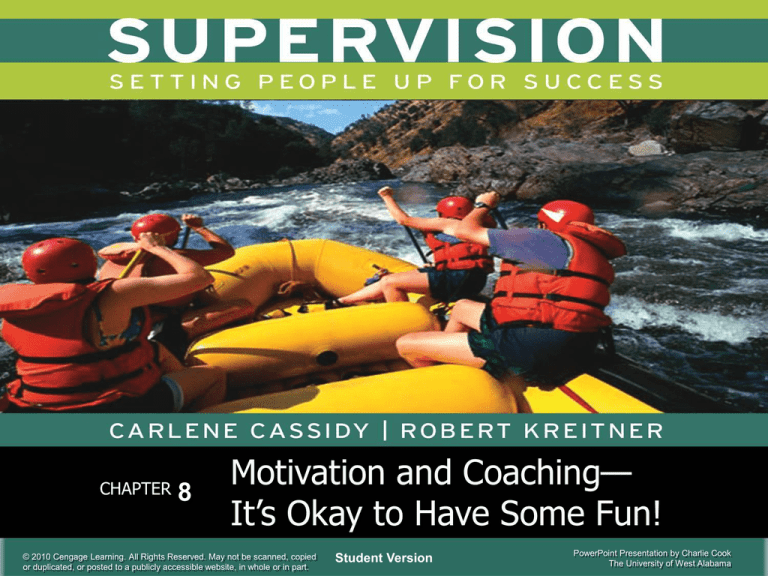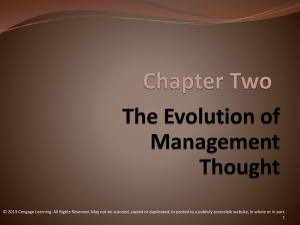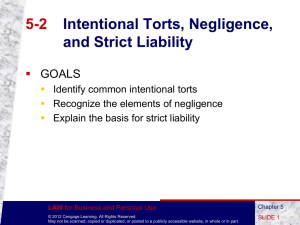
CHAPTER
8
Motivation and Coaching—
It’s Okay to Have Some Fun!
© 2010 Cengage Learning. All Rights Reserved. May not be scanned, copied
or duplicated, or posted to a publicly accessible website, in whole or in part.
Student Version
PowerPoint Presentation by Charlie Cook
The University of West Alabama
Learning Objectives
1. Discuss employee motivation and related myths about what
motivates employees.
2. Compare different motivation theories and discuss their relevance for
supervisors.
3. Describe the components of goal setting.
4. Describe techniques that can be used to support employee
motivation.
5. Explain the supervisory role of coaching and the difference between
training and coaching, and discuss components involved in
developing a productive coaching relationship.
6. Describe strategies for developing peak performers through coaching
and delivering effective feedback.
© 2010 Cengage Learning. All Rights Reserved. May not be scanned, copied
or duplicated, or posted to a publicly accessible website, in whole or in part.
8–2
Employee Motivation:
Myths and Motivators
• Motivation
Is an employee’s desire or drive to achieve.
Is essential to organizational success.
• Motivation Debate:
Supervisors cannot motivate employees
Motivation comes from within—supervisor’s job is to create a
working environment where people will motivate themselves.
Supervisors can motivate employees
Supervisors can “motivate” employees with appropriate
words, actions, and decisions.
© 2010 Cengage Learning. All Rights Reserved. May not be scanned, copied
or duplicated, or posted to a publicly accessible website, in whole or in part.
8–3
1. Do you agree or disagree with the statement that
supervisors cannot motivate employees, people
motivate themselves? Explain.
2. Reflect on a personal experience where someone
was supervising your activities or leading a team.
This may be at work, in a volunteer capacity, or
through extracurricular activities. Did the leader’s
words, actions, and decisions impact your
motivation? Explain.
© 2010 Cengage Learning. All Rights Reserved. May not be scanned, copied
or duplicated, or posted to a publicly accessible website, in whole or in part.
8–4
Important Motivation Theories
• Content Theories: What is Motivation?
Maslow’s hierarchy of needs theory
Herzberg’s two-factor theory
Job enrichment theory
• Process Theories: How Does Motivation Work?
Expectancy theory
Goal-setting theory
© 2010 Cengage Learning. All Rights Reserved. May not be scanned, copied
or duplicated, or posted to a publicly accessible website, in whole or in part.
8–5
1. Make a list of your own top five motivators.
1.
2.
3.
4.
5.
2. Now, work in groups with your classmates to
compare lists. What do you have in common? What
is unique? Are there any surprises?
© 2010 Cengage Learning. All Rights Reserved. May not be scanned, copied
or duplicated, or posted to a publicly accessible website, in whole or in part.
8–6
FIGURE 8.2 Maslow’s hierarchy of needs theory
© 2010 Cengage Learning. All Rights Reserved. May not be scanned, copied
or duplicated, or posted to a publicly accessible website, in whole or in part.
8–7
Relevance of Maslow’s Theory
for Supervisors
• Only unfulfilled needs motivate people.
• Each individual is motivated by a unique
combination of unfilled needs.
• More than one need at a time may be acting on
a person.
• Focusing on an individual’s desire for esteem
presents supervisors with the greatest
opportunity to motivate better performance.
© 2010 Cengage Learning. All Rights Reserved. May not be scanned, copied
or duplicated, or posted to a publicly accessible website, in whole or in part.
8–8
Herzberg’s Two-Factor Theory
• Satisfiers
Are task-related factors that are responsible for self-
motivation of individuals.
• Dissatisfiers
Are job context factors that produce dissatisfaction in
employees.
• Implications
Satisfaction is not the opposite of dissatisfaction.
Satisfaction does not necessarily produce motivation.
Eliminating dissatisfaction is not the same as motivating.
Enriched jobs that provide challenges motivate most
employees.
© 2010 Cengage Learning. All Rights Reserved. May not be scanned, copied
or duplicated, or posted to a publicly accessible website, in whole or in part.
8–9
Job Enrichment
• Job Enrichment Theory
Posits that redesigning the complexity and depth of a
job’s core dimensions to be more, meaningful,
interesting, and challenging increases its motivating
potential.
Is effective when applied to capable individuals who
have a desire for personal growth.
© 2010 Cengage Learning. All Rights Reserved. May not be scanned, copied
or duplicated, or posted to a publicly accessible website, in whole or in part.
8–10
Expectancy Theory
• Expectancy
Refers to the subjective probability (that is, the belief )
that one thing will lead to another.
Is the motivational belief of employees that a given
level of effort will lead to specific level of performance
which, in turn, will result in a desired personal reward
(a specific valued outcome).
• Relevance of Theory For Supervisors
Motivational strength of an employee’s desire to
perform increases as the employee’s perceived effortperformance and performance-reward probabilities
increase.
© 2010 Cengage Learning. All Rights Reserved. May not be scanned, copied
or duplicated, or posted to a publicly accessible website, in whole or in part.
8–11
Goal-Setting Theory
• Goal Setting
Is the process of improving individual or group job
performance with formally stated objectives,
deadlines, or quality standards.
• Implications:
Specific difficult goals can trigger a motivational
process that improves performance.
Goal effectiveness in motivating performance is
enhanced by specificity, difficulty, and participation.
Motivation is increased when specific goals are
accompanied by equally specific feedback.
© 2010 Cengage Learning. All Rights Reserved. May not be scanned, copied
or duplicated, or posted to a publicly accessible website, in whole or in part.
8–12
Motivation in Action: Techniques to
Support Employee Motivation
1. Motivating employees starts with motivating yourself
2. Always work to align goals of the organization with
goals of employees
3. Key to supporting the motivation of your employees is
understanding what motivates each of them
4. Recognize that supporting employee motivation is a
process, not a task
5. Use organizational systems (i.e., policies and
procedures)
© 2010 Cengage Learning. All Rights Reserved. May not be scanned, copied
or duplicated, or posted to a publicly accessible website, in whole or in part.
8–13
Supervisory Roles:
Beginning with Coaching
• Supervisors who help their employees tend to
create weak, dependent, and passive people.
• Supervisors who coach create strong, selfconfident, and proactive individuals.
• Coaching
Involves guiding employees when learning a new
task, skill, or information and connecting the “How”
with the “Why.
© 2010 Cengage Learning. All Rights Reserved. May not be scanned, copied
or duplicated, or posted to a publicly accessible website, in whole or in part.
8–14
Cultivating a Productive Coaching
Relationship
Setting Employees
Up for Success
A Winning Attitude
A Positive
Self-Image
© 2010 Cengage Learning. All Rights Reserved. May not be scanned, copied
or duplicated, or posted to a publicly accessible website, in whole or in part.
Set a Higher
Standard
8–15
You cannot be a parent, a manager, a leader, a teacher, or
a coach and be effective if you don’t have a good selfimage. We’re going to make mistakes and oftentimes,
we’re going to make many—but let’s learn and let’s benefit
from them. Do what’s right and avoid what’s wrong. It’s that
simple. Sometimes we blame everybody and everything
around us to the point where it gets ridiculous.
1. Do you agree or disagree with Lou Holtz’s comments
above? Explain.
2. How do you think supervisors should respond when
one of their employees makes a mistake?
© 2010 Cengage Learning. All Rights Reserved. May not be scanned, copied
or duplicated, or posted to a publicly accessible website, in whole or in part.
8–16
Strategies for Developing
Peak Performers
• Creating a Safe Environment
It is essential that your employees know you do not
expect perfection.
It is important that employees feel comfortable
bringing mistakes to your attention.
Dealing constructively with mistakes needs to be
focused on the organization’s mission and driven into
the organization’s culture.
Use errors as “teachable moments to help employees
learn from mistakes so they are not repeated.
© 2010 Cengage Learning. All Rights Reserved. May not be scanned, copied
or duplicated, or posted to a publicly accessible website, in whole or in part.
8–17
Timing Matters
Characteristics of
Teachable Moments
Conflict
Resonance
© 2010 Cengage Learning. All Rights Reserved. May not be scanned, copied
or duplicated, or posted to a publicly accessible website, in whole or in part.
Surprise
8–18
Communicating Effective Feedback
• Positive Feedback
Is intended to reinforce good behavior.
Must be unique, timely, and specific to be effective.
Is regarded a genuine and credible if it comes from a
trusted source.
Can be a source of pride and motivation.
• Constructive Criticism
Redirects employees to correct their errors.
Focuses on the desired behavior rather than the
person.
© 2010 Cengage Learning. All Rights Reserved. May not be scanned, copied
or duplicated, or posted to a publicly accessible website, in whole or in part.
8–19
FIGURE 8.6 The 10 values of a successful Staff Coach
1. Clarity—giving and receiving accurate communication.
2. Supportiveness—a commitment to stand with and behind team members.
3. Confidence building—personal commitment to build and sustain the selfimage of each team member.
4. Mutuality—a partnership orientation whereby everyone wins or no one
wins.
5. Perspective—focus on the entire business enterprise.
6. Risk—encouragement of innovation and effort that reduces punishment for
mistakes and fosters learning by doing.
7. Patience—going beyond the short-term business focus to a view of time
and performance that balances long-term gain and business imperatives.
8. Involvement—genuine interest in learning about individuals in order to
know what incentives, concerns, and actions will inspire them.
9. Confidentiality—an ability to protect information of all team interactions and
cause a sense of trust and comfort with the individuals.
10. Respect—ongoing mutual respect.
© 2010 Cengage Learning. All Rights Reserved. May not be scanned, copied
or duplicated, or posted to a publicly accessible website, in whole or in part.
8–20
If you slather it on when just a “nice job” will do, employees and
coworkers will doubt your sincerity—or think you’re surprised by
their competence.
A corollary: Be specific. People respect a boss who knows which
tasks are toughest to pull off .
Pat the right back. Nothing makes employees more cynical than
the boss’s public praise of someone whose work on a project was
minimal or nonexistent.
1. Personally, how important is supervisory feedback to you
doing your best on the job?
2. What experience have you had with positive, inadequate, or
inappropriate feedback from your boss? Explain what
happened.
© 2010 Cengage Learning. All Rights Reserved. May not be scanned, copied
or duplicated, or posted to a publicly accessible website, in whole or in part.
8–21
1. Which of the coaching skills, attributes, and values
listed in Figure 8.6 have you currently mastered or
developed well?
2. How can you develop more confidence in the other
coaching skills, attributes, and values that you did
not list previously?
© 2010 Cengage Learning. All Rights Reserved. May not be scanned, copied
or duplicated, or posted to a publicly accessible website, in whole or in part.
8–22
TERMS TO UNDERSTAND
coaching
conflict
constructive criticism
expectancy
goal setting
Herzberg’s two-factor theory
inquiry
job enrichment theory
Maslow’s hierarchy of needs theory
motivation
positive feedback
resonance
© 2010 Cengage Learning. All Rights Reserved. May not be scanned, copied
or duplicated, or posted to a publicly accessible website, in whole or in part.
8–23







